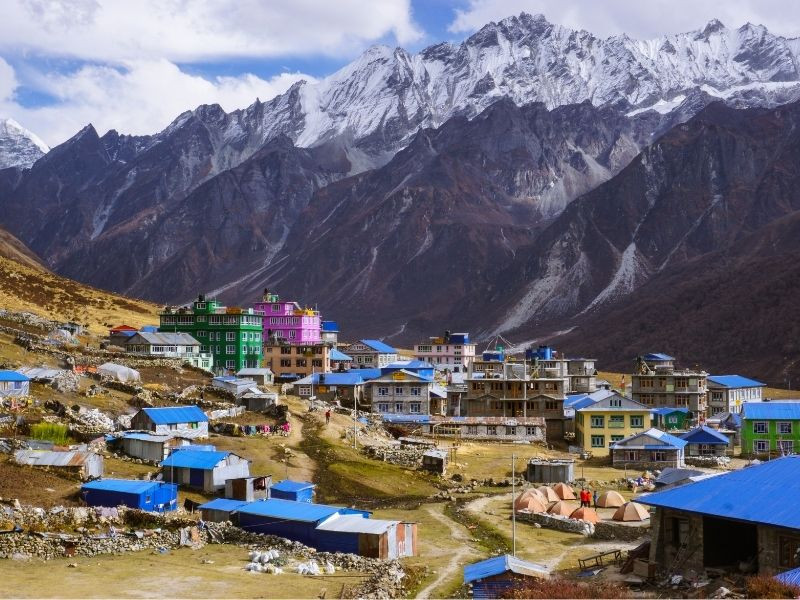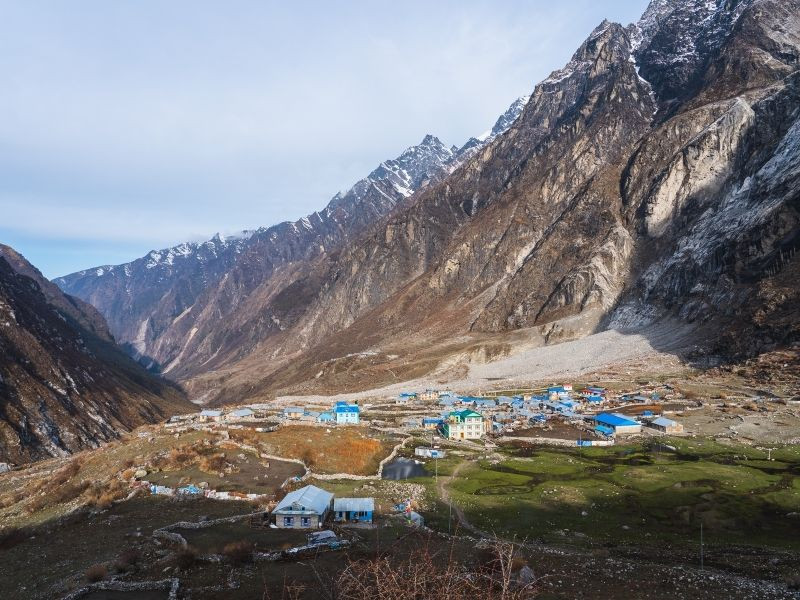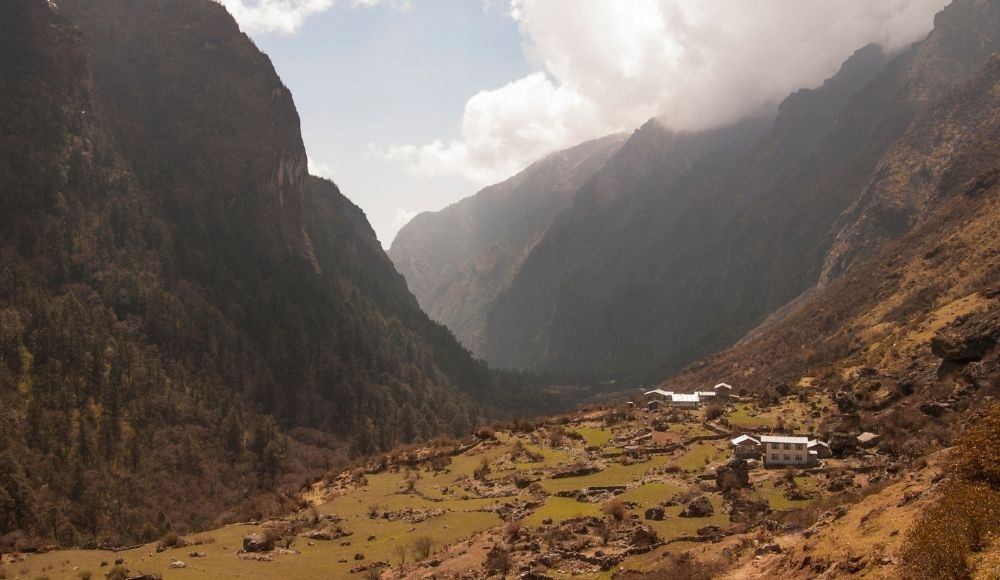Tamang Heritage Trail
Trip Facts
Trip Highlights
- Spectacular Himalayan Vistas including Langtang, Ganesh Himal and Sanjel Himal Ranges.
- The impeccable cultural attractions of Tamangs.
- Awe-inspiring Langtang Valley and lush surroundings.
- Natural and Cultural attractions throughout the trek.
- A comprehensive peek into the remote life of people, their culture and natural landscapes.
Trip Overview
Most travelers who visit Nepal are able to enjoy Everest, the Annapurna circuit and high-altitude treks in the Kathmandu Valley. Others come for the non-trekking experiences in the Himalayan kingdom. The Tamang Heritage Trail Trek was designed for people who have less time to spend than long offbeat treks but still want to ‘do it all’. During the trek, you'll have every opportunity to explore several ‘must sees’ of the Himalayan kingdom: Langtang, Kerung, and the Ganesh Himal, Sanjen Himal ranges. You'll also get a chance to check out numerous waterfalls and beautiful meadows. The high-altitude forests on this trek are thick with Rhododendrons and Blueberry bushes.
The Tamang Heritage Trail in Nepal is an incredible trekking area for nature and culture explorers. It is a walking trail that features the lifestyle of the Tamang people who live in the Himalayan ranges of Northern Nepal. This trail is designed to give the tourist a richer and more culturally enlightening experience. Along the way, travelers will learn about the Tamang culture and experience a variety of natural landscapes and beautiful scenery.
The Tamang people are an indigenous ethnic group living in Nepal. They call themselves ‘Tamang’ which means ‘people of the mountains’. The Tamangs have retained their traditional lifestyle, including attire, food and customs for centuries.
Along the way, tourists will be able to visit hot water springs, sacred sites for Hindus and Buddhists, the highest peaks in Nepal as well as cultural villages. The path also passes by Langtang National Park and some wetlands.
Tamang Heritage Trail provides a glimpse into Himalayan culture and way of life. The Trail introduces you to the lush central belt of Nepal, allowing you to admire the natural beauty of the mountains and learn about the inhabitants' culture. Traditional Tamang villages, whose life, culture, and crafts have not altered much since the settlement's origin, are traversed by the trail. The magnificent grandeur of the locals' mountain homes, their ornate attire, and the historic monasteries and places of worship provide richness to the experience of this trail. The journey gives a wilderness experience in addition to cultural exposure through stunning alpine terrain, meadows, and wonderful rhododendron forests.
Tamang Heritage Trek Facts
|
Trip Name |
Tamang Heritage Trail Trek |
|
Trip Type |
Trekking |
|
Duration |
14 Days |
|
Highest Elevation |
3860 M |
|
Start/Finish |
Kathmandu |
|
Difficulty |
Strenuous |
|
Total Trekking Distance |
140-200 KM |
|
Best Time to Trek |
|
|
Accommodation |
Teahouse and Lodge |
|
Average trekking per day |
6-7 Hours |
|
Permits Required |
National Park Entry Permit, TIMS |
|
Route: Kathmandu - Syabrubesi - Gatlang - Tatopani - Thuman - Briddim - Lama Hotel- Langtang village - Lama Hotel - Syabrubesi - Kathmandu |
|
What is Tamang Heritage Trail?
Either Dhunche or Syabrubosi serves as the trail's starting points. The route then travels via Goljung, Gatlang, Chilime, Thuman, Timure, and Briddim. Following the Langtang trip from Briddim hamlet via Khamjim, the track may conclude back in Syabrubesi. Traditional Tamang settlements can be found at Goljung and Gatlang. There is a historic monastery in Goljung. One can get a panoramic picture of the Langtang, Kerung, Ganesh Himal, and Sanjen Himal ranges from the viewpoint at Bahundanda, which is close by.
The Tamang community of Gatlang is located high up on a mountainside amidst terraced fields. Gatlang has the lovely Parvatikunda Lake and a Tamang monastery that may be visited. It is a thrilling experience to take a bath in the warm, therapeutic waters of the natural spring at Tatopani while travelling from Gatlang to Chilime. In a community-run homestay, Brimdang offers a cultural experience whereas Nagthali provides an incredible view of spectacular Himalayan ranges.
From Nagthali, it is possible to clearly see the Langtang, Kerung, Ganesh Himal, and Sanjen ranges. Visitors who are interested can spend one extra night in Nagthali at the recently constructed hotel lodge. The monks and priests of the area used to frequent Nagthali as a place for meditation. After Nagthali, Thuman is the next cultural village. Shamanic performances and a stunning view of Langtang are two of Thuman's most well-known attractions. Every home in Thuman offers a stunning view of the mountains. Next is Timure, which is located on the former trade route to Tibet. The long-standing links between Nepal and Tibet are commemorated historically by the fort at Rasuwagadhi near Timure. Here, a suspension bridge connects Tibet with Nepal.
Briddim Village
Briddim, a small but picturesque Tamang village, is situated at an elevation of 2,229 meters. It offers accommodations that provide access to Himalayan cultural experiences. Here, travellers are hosted as house guests so they can directly experience the traditional culture and hospitality of the Tamang people. The village’s home-stay tourism management committee oversees the lodging and travel package. At the International Mountain Day event held in Kathmandu in December 2005, Briddim Home-Stay received the second Mountain Development Prize. This village is also one of the most beautiful villages where you can cherish the incredible beauty of cultural and natural attractions.
Culture and Lifestyle of People
It is believed that the people of the Langtang Valley are descended from Tibetans from Kerung who mixed with Tamangs from the Helambu region. Although the people who live in Briddim, Thuman, Timure, and Langtang are of the Tamang ethnic group, Tibetan culture and tradition can be clearly seen in their lifestyle, which is very similar to that of the majority of Tibetan villages. They primarily raise sheep and yaks, but they also cultivate certain hardy cereals and vegetables.
The residents' daily activities include farming, rearing livestock, and trading with Kerung in Tibet. Their major foods are millet, wheat, corn, potatoes, and soybeans. Additionally, during important festivals like Lhosar (February), Chhiju (December), and Baisakh Purnima (April/May), tourists can see Syabru dance, Khampa dance, Shaman performances, and other vibrant acts.
Natural Hot Springs
In the naturally occurring hot springs with bathing areas in the foothills of the Alps at Tatopani, which literally means ‘hot water’, you can purify your soul. The waters, in accordance with local belief, offer a curative nature that relieves your aches and pains.
Langtang Valley and National Park
Since it was made a national park in 1976, the Langtang Valley, which is home to some 1,710 square kilometers, has remained Nepal's second-largest park. It has a high level of biodiversity, with 15 different forest types, 3,000 varieties of blooming plants, such as oaks, fir, blue pine, and spruce, as well as more than 10 different species of rhododendron. It stretches all the way up to the Tibetan border. Additionally, there are several therapeutic plants in the Park. Approximately 46 species of mammals and 283 species of birds, including musk deer, snow leopards, red pandas, wild dogs, Himalayan black bears, and clouded leopards, can be found in the region’s extensive forests and diverse flora types.
Gosainkunda Trek
From Rimiche, Syabrubesi, or Dhunche, it takes an additional 4-5 days to hike to the holy Gosainkunda Lake (4,300 m.). The walk provides the ideal fusion of natural and cultural heritage. Both Hindus and Buddhists revere the lake known as Gosaikunda. During the Janai Purnima festival, which takes place in August during the full moon, between 25 and 30 thousand pilgrims travel to this region.
Visitors can prolong their stay in Langtang by going on a trip to Kyangjin and then exploring the upper valley all the way to Langshisa and beyond. Tilman's Col, a treacherous crossing that heads east toward Panchpokhari and is named after H.W. Tilman, the first Westerner to visit Langtang in 1949. Leading south to Helambu and the Kathmandu Valley is Ganja La pass (5,120 m), which is frequently shrouded in snow and clouds can be explored.
Related Trip: Langtang Gosaikunda Lake Trek
Accommodation Facilities
Gatlang has a community lodge that provides lodging. At Briddim, lodging is available as packaged services of homestay. In the remaining settlements, meals are provided along with lodging in addition to the usual hotel, lodge, and private homestay options. The straightforward yet filling meals are a culinary adventure because they are prepared with special attention to food safety. There are also trained porters and guides available in the villages.
Difficulty
Tamang Heritage Trail is a moderately difficult trek. One of the aspects to consider when tramping through a trail is the terrain. Having elevations beneath 4000 m, The trek offers magnificent mountain experiences to the visitors. The chances of altitude sickness are comparatively lower than in other high-elevation trekking areas. Another key aspect to consider while trekking in the mountains is the availability of accommodation facilities. Most of the places that you will be stopping for overnight stays have some sort of accommodation facilities. The teahouses, homestays and small lodges are mostly available in the trekking area. So, in terms of the stay facility, this is one of the moderate treks in Nepal.
Another aspect to consider during the trek is the ability of the terrain to bear weight. For instance, if you trek through a trail that has a lot of loose stones and rocks, it is important for you to be physically fit as this can often result in injury or difficulty. Some parts of the trail may have bumps, however, the trail is mostly in beautiful terrain, allowing you to explore the most beautiful mountain vistas in the Langtang area.
A person with modest physical fitness and endurance can easily complete the trek and enjoy the natural scenery. The culture and lifestyle of locals are the major attractions of the trek which you can explore thoroughly throughout the trek.
Best time to visit
The best time to visit Tamang Heritage Trail is during the Spring and Autumn seasons. You can explore a wide range of climatic variations and the trekking atmosphere while trekking in this area. Seasoned locals will tell you that the best time to visit Tamang Heritage Trail is during the dry winter months- December through March. Though there are many benefits to visiting during any season, these dry months offer a more moderate climate with cooler days and warmer nights as well as access to less crowded trails and routes. This also means abundant water sources in addition to fewer bugs and biting animals. So, visiting the Tamang Heritage trail during the spring and Autumn months can be rewarding with picturesque views and an uninterrupted trekking experience.
The wet seasons such as Summer and Winter can be harsh with unpredictable snowfall and gloomy weather. However, trekking can still be possible by looking after the weather forecast.
Detailed Itinerary
Kathmandu Arrival | Welcome to Nepal!
Kathmandu Cultural Sightseeing.
Kathmandu - Dhunche - Syabru drive
Trek from Syabrubesi to Gatlang.
Gatlang -Tatopani via Thambuchet
Tatopani - Brimdang - Nagthali - Thuman.
Thuman to Briddim.
Briddim to Lamahotel.
Lama Hotel - Langtang valley.
Langtang - Kyanjin Gompa.
Kyanjin Gompa-Lamahotel.
Lamahotel-Syabrubesi.
Syabrubesi - Kathmandu.
Departure.
Trip Guide
The given information about the Tamang Heritage Trail is in-depth, feel free to contact us 24/7 for any kind of assistance. We will be available on WhatsApp to assist you instantly. You can write an email if this trip doesn't fit with your vacation schedule and requirements. We aim to offer the best possible travel experience to the customers. Depending on the needs of the visitors and the group size, we customize each vacation package. We will put together a bespoke itinerary just for your private group.
Frequently Asked Questions
-
Where is the Tamang Heritage trail?
Tamang heritage trail is in the northern part of Nepal, near the Tibetan border. Most of the Tamang heritage trails lie in the Langtang region and offer a wonderful experience to the trekkers. Relatively unexplored and culturally enriched this trail is popular for its mind-blowing cultural and natural experiences. The trail generally starts right after you reach Syabrubesi and heads towards the beautiful ethnic and cultural villages of Gatlang, Tatopani, Thuman, Briddim, Kyanjin Gompa and Langtang valley.
-
Do I need a restricted area permit for this trek?
No, the Langtang region is not under a restricted area. You can obtain the necessary permits such as a TIMS card and National Park permit and enjoy the trek in this region.
-
How difficult is the Tamang Heritage trek?
The trek is moderate. Mostly, you will be trekking in an area below 4000 m. above sea level, so, there are less chances of altitude sickness and you can easily complete the trek. It is not physically demanding, however, we suggest you make your backpack as light as possible.
-
What is a useful backpacking checklist for this trek?
While trekking on the Tamang heritage trail, you can take the necessary items. We recommend you carry essential items only as you will not be needing heavy equipment and gear. A light backpack is very helpful during the trekking journey. For the backpacking checklist, please visit our Nepal Trekking Gear Checklist.
-
What are the major attractions of the Tamang Heritage Trail?
The major attractions of the Tamang heritage trail are the beautiful waterfall, lush valleys, Langtang National Park, the culture and traditions of Tamangs and the Tibetan influence on the culture of the locals. Besides that, the beautiful natural landscapes and mountain sceneries are widely admired. The Langtang valley extension in the Tamang heritage trail also makes the experience wonderful as you can explore the most astonishing vistas.
Services Includes
-
Kathmandu airport transfer on arrival and departure.
-
Private vehicle with A/C for all mentioned sightseeing and transfers.
-
All (11 nights) hotel accommodations at the mentioned hotels and resorts/ teahouses at respective places.
-
Daily breakfast at the hotel/tea houses from the next day of your arrival.
-
Lunch and Dinner as mentioned in the itinerary during your trek trip.
-
English-speaking professional and government-licensed tour guide during your sightseeing at Kathmandu.
-
All necessary paperwork. (National Park Permit and TIMS Card)
-
Professional and experienced trekking guide during your trekking trip.
-
Guide’s salary, food and accommodation during the trip.
-
Arrangement of emergency helicopter service which will be paid by your traveler’s insurance company.
-
All mentioned sightseeing entrance fees and permits.
-
One local SIM card (returnable, if required) during your stay.
-
All government and local taxes.
-
Farewell Nepali cultural dinner on your last night in Nepal.
Services Excludes
-
Personal expenses.
-
Lunch and dinner in Kathmandu.
-
Nepal visa cost. (You will require 2 passport-size photos and 30 USD)
-
International flight ticket.
-
Travel health insurance. (Recommended)
-
Tips for the guide, porter and driver.
-
Sweet things like dessert/chocolate.
-
All alcoholic and non-alcoholic drinks.
-
Hot shower/batteries charge/heater during the trek.
Why Travel With Altitude Himalaya?
We believe in the quality services to accommodate our guests 360 degrees need with tour personalization and customization. Our dedicated and experienced team believes not only in arranging trips, but making creating life long memories. Our travel experience within the region of Nepal, Bhutan and Tibet could make a memorable trip of yours.
Confirm Your reservation Now


TALK TO AN EXPERT
we can help you find your perfect holiday
Mr. Kiran has experience of 10+ years in tourism across Nepal, Bhutan and Tibet holiday arrangements to thousands of travellers from around the world. He will help you to figure out the best possible vacation plan according to your choice and preference.







 Duration
14 days
Duration
14 days
 Trip Difficulty
Moderate
Trip Difficulty
Moderate
 Trip Code
THT
Trip Code
THT
 Start Point
Kathmandu
Start Point
Kathmandu
 Trip End Point
Kathmandu
Trip End Point
Kathmandu
 Accomodation
As Mentioned
Accomodation
As Mentioned
 Meals
As mentioned
Meals
As mentioned
 Transportation
As mentioned
Transportation
As mentioned
 1350 M
1350 M
 2238 M
2238 M
 Send an email
Send an email +9779823000055
+9779823000055 +9779823000055
+9779823000055